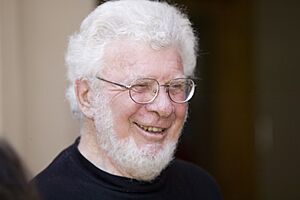Leonard Herzenberg facts for kids
Quick facts for kids
Leonard Herzenberg
|
|
|---|---|

Herzenberg in 2006
|
|
| Born |
Leonard Arthur Herzenberg
November 5, 1931 New York City, US
|
| Died | October 27, 2013 (aged 81) |
| Alma mater | Brooklyn College California Institute of Technology |
| Known for | Flow cytometry (FACS) |
| Spouse(s) | Leonore Herzenberg |
| Children | 4, including Jana |
| Awards | Kyoto Prize (2006) |
| Scientific career | |
| Fields | Immunology, genetics |
| Institutions | Stanford University Pasteur Institute |
| Thesis | Studies on a Cytochrome Destroying System in Neurospora (1956) |
| Doctoral advisor | Herschel K. Mitchell |
Leonard Arthur "Len" Herzenberg (born November 5, 1931 – died October 27, 2013) was a brilliant scientist. He was an immunologist, which means he studied the body's immune system. He was also a geneticist, someone who studies genes and heredity. Len was a professor at Stanford University. He made amazing discoveries in cell biology, which is the study of cells. His work helped scientists sort living cells based on their unique features.
Contents
Learning and Early Life
Len Herzenberg was born in New York City on November 5, 1931. He loved learning about science from a young age.
In 1952, he earned his first college degree. He studied both biology and chemistry at Brooklyn College. Later, in 1955, he received his Ph.D. from California Institute of Technology. This is a very high degree in science. His special area of study was biochemistry, focusing on immunology. He studied something called cytochrome in a type of mold called Neurospora.
Making a Difference: His Career
After finishing his studies, Len went to France. He worked at the Pasteur Institute, a famous research center. He was a postdoctoral fellow there. This means he was a scientist doing advanced research after getting his Ph.D.
In 1957, he came back to the United States. He worked for the National Institutes of Health. This is a big government agency that helps with medical research. In 1959, he started working at Stanford University. He eventually became a Professor of Genetics there.
The Fluorescence-Activated Cell Sorter
In 1970, Len Herzenberg developed a revolutionary machine. It was called the fluorescence-activated cell sorter, or FACS. This machine changed how scientists studied the immune system and cancer.
The FACS machine made it possible to quickly sort different types of cells. It could separate cells based on their specific features. This was a huge step forward for science. It also helped purify adult stem cells. Stem cells are special cells that can turn into many different cell types.
Coined the Term "Hybridoma"
Between 1976 and 1977, Len spent time in another scientist's lab. This was the lab of Cesar Milstein. During this time, Len came up with a new word: "hybridoma."
Hybridomas are special hybrid cells. They are made by combining two different types of cells. These are B cells, which are part of the immune system, and myeloma cells, a type of cancer cell. Hybridomas are very important for making special antibodies used in medicine.
Life Outside Work
Len Herzenberg and his wife, Leonore Herzenberg, were a scientific team. They worked together in the Herzenberg Laboratory at Stanford. They continued their research together until Len's death.
They had four children. Their daughter, Jana Herzen, is a talented singer-songwriter. She also started her own music company called Motéma Music. Len Herzenberg passed away on October 27, 2013, at the age of 81.
Awards and Special Recognitions
Len Herzenberg received many awards and honors for his important work. Here are some of them:
- 1998 American Association of Immunologists Lifetime Achievement Award
- 2002 Edwin F. Ullman Award, American Association of Clinical Chemistry
- 2004 Special Novartis Prize for Immunology (he was the only person to ever win this award!)
- 2005 Abbott Laboratories Award in Clinical and Diagnostic Immunology, American Society for Microbiology
- 2006 Kyoto award for his work in cell biology
- 2007 Ceppellini Award, International Foundation for Research in Experimental Medicine. He shared this award with his wife, Lee Herzenberg, for their amazing contributions to medicine.
- 2013 ABRF Annual Award for Outstanding Contributions to Biomolecular Technologies

